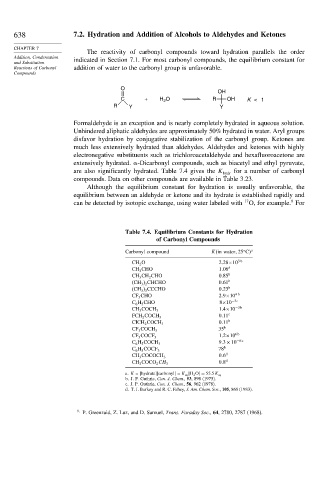Page 656 - Advanced Organic Chemistry Part A - Structure and Mechanisms, 5th ed (2007) - Carey _ Sundberg
P. 656
638 7.2. Hydration and Addition of Alcohols to Aldehydes and Ketones
CHAPTER 7
The reactivity of carbonyl compounds toward hydration parallels the order
Addition, Condensation
and Substitution indicated in Section 7.1. For most carbonyl compounds, the equilibrium constant for
Reactions of Carbonyl addition of water to the carbonyl group is unfavorable.
Compounds
O
OH
C + H O R OH K < 1
2
R Y Y
Formaldehyde is an exception and is nearly completely hydrated in aqueous solution.
Unhindered aliphatic aldehydes are approximately 50% hydrated in water. Aryl groups
disfavor hydration by conjugative stabilization of the carbonyl group. Ketones are
much less extensively hydrated than aldehydes. Aldehydes and ketones with highly
electronegative substituents such as trichloroacetaldehyde and hexafluoroacetone are
extensively hydrated.
-Dicarbonyl compounds, such as biacetyl and ethyl pyruvate,
are also significantly hydrated. Table 7.4 gives the K hydr for a number of carbonyl
compounds. Data on other compounds are available in Table 3.23.
Although the equilibrium constant for hydration is usually unfavorable, the
equilibrium between an aldehyde or ketone and its hydrate is established rapidly and
9
17
can be detected by isotopic exchange, using water labeled with O, for example. For
Table 7.4. Equilibrium Constants for Hydration
of Carbonyl Compounds
Carbonyl compound K in water 25 C a
CH 2 O 2 28×10 3b
CH 3 CHO 1 06 b
CH 3 CH 2 CHO 0 85 b
(CH 3 ) 2 CHCHO 0 61 b
(CH 3 ) 3 CCCHO 0 23 b
CF 3 CHO 2 9×10 4b
C 6 H 5 CHO 8×10 −3c
1 4×10 −3b
CH 3 COCH 3
0 11 c
FCH 2 COCH 3
0 11 b
CICH 2 COCH 3
35 b
CF 3 COCH 3
1 2×10 6b
CF 3 COCF 3
9 3×10 −6c
C 6 H 5 COCH 3
78 b
C 6 H 5 COCF 3
0 6 d
CH 3 COCOCH 3
0 8 d
CH 3 COCO 2 CH 3
a. K = [hydrate][carbonyl] = K eq H 2 O = 55 5K eq
b. J. P. Guthrie, Can. J. Chem., 53, 898 (1975).
c. J. P. Guthrie, Can. J. Chem., 56, 962 (1978).
d. T. J. Burkey and R. C. Fahey, J. Am. Chem. Soc., 105, 868 (1983).
9
P. Greenzaid, Z. Luz, and D. Samuel, Trans. Faraday Soc., 64, 2780, 2787 (1968).

